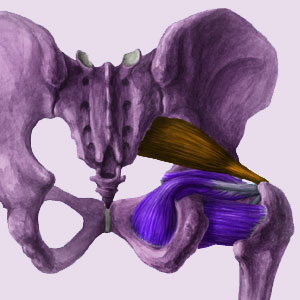
Piriformis hypertrophy is a general diagnostic finding wherein the muscle is considered to be larger than normal, due to inflammation, imbalance or other cause. Hypertrophy is often noted as evidence towards a diagnosis of piriformis syndrome, although there is much controversy about its role in contributing to sciatic or pudendal nerve compression. To add even more controversy, muscular atrophy is also noted as a contributing factor to piriformis syndrome, even though it denotes a condition that is the exact opposite of hypertrophy.
How important is a diagnostic discovery of a hypertrophic piriformis muscle and is the diagnosis even accurate? We take a look at this question using a combination of the latest research and our own clinical experience in various healing arts and sciences. If you want to better understand hypertrophy of the piriformis muscle, you are in the right place to learn.
What is Piriformis Hypertrophy?
Enlargement of the piriformis muscle is also called hypertrophy. This condition is controversial since there is no specific size for the piriformis muscle to be and it is possible for the size and shape of the muscle to differ proportionately from patient to patient. This makes the diagnosis incredibly subjective in virtually all cases.
Hypertrophy can be pronounced due to the permanent state of the muscle when it is simply larger than is considered textbook normal. Hypertrophy can also be pronounced when the muscle s obviously being affected by some transient or semi-permanent process that is causing it to become larger.
Hypertrophy is virtually always diagnosed via MRI film, although CT scan can also be used to gather evidence towards this conclusion.
Muscular Hypertrophy Causes
Hypertrophy may not exist at all despite a diagnosis. Instead, the large size may simply reflect the muscle’s natural state. Basically, a given piriformis might actually not be hypertrophic at all, but instead be simply larger than those found in the average person. Once again, subjectivity is a widespread issue and certain types of imaging views can actually worsen this problem, exaggerating the size of the muscle from specific vantage points.
When the muscle is larger than normal due to temporary or persistent circumstances, the cause is usually one of the following conditions:
Injury to the piriformis might cause inflammation or scar tissue that can add bulk to the muscle. Injury is usually a transient factor, but may result in lasting hypertrophic issues in rare cases.
Imbalances in paired antalgic groupings of muscles can cause the piriformis to grow larger, stronger and tighter than its match. Muscular imbalances remain highly debated diagnoses as well, with many patients being subjectively diagnosed and treated illogically.
Is Piriformis Hypertrophy Pathological?
If the sciatic nerve is unusually placed, being located through the piriformis muscle or wrapped around it is some atypical manner, hypertrophy may be a contributing factor towards nerve compression. This is logical and can often be observed using diagnostic imaging in combination with other neurological testing. However, in most cases, hypertrophy of the piriformis may be a coincidental factor in many painful conditions. In fact, as noted above, the piriformis might simply be larger than is deemed normal and is not hypertrophic at all in a given individual.
Since the opposite diagnosis of piriformis atrophy is used to justify an equal number of piriformis pain conditions due to the exact same causative reasons, injury and imbalances, many doctors are suspicious of the validity of hypotrophy conditions as being the source of any pain. We tend to agree with this consensus in many patients, but have seen some cases where hypertrophy is a definitive contributing factor to ongoing symptomology. Therefore, we urge all patients to seek out expert diagnostic processing from an expert in piriformis syndrome and be certain to get a second opinion before acting on any treatment advice provided in order to enjoy optimal therapeutic results.
Piriformis Pain > Causes of Piriformis Pain > Piriformis Hypertrophy





